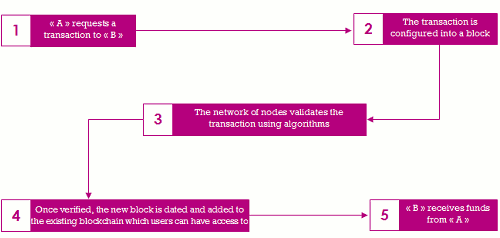Blockchain: definition and mode of functioning
 |
Blockchain is a technology that allows the storage and the transmission of information or transactions. It is a global database shared by several users. The novelty: the solution operates without any central control unit, with everyone being able at any time to double check the validity of information, add data and report a transaction by means of a cryptographic system.
Blockchain for novice users: operating mode
When a user carries out a transaction through the blockchain network, it is gathered with other related transactions within a block. It is later verified and validated by members of the network by means of cryptographic techniques. This stage, called mining, allows to verify the transaction authenticity, to ensure that its structure is correct and consistent with already reported previous transactions.
Once validated, the block is immediately timestamped and added to the blockchain, rendering the operation visible and accessible to all users but it cannot be modified even in the event of any mistake. When such situation occurs, the correction of the mistake will require just the addition of a new transaction.
The deadline for the validation of a transaction is almost instantaneous, varying however according to the importance of the transaction carried out. Generally, one has to wait for 10 minutes before obtaining a confirmation of the transaction.
Blockchain for novice users: Safe technology
Open system does not necessarily mean insecure system. The technique used is protected against falsification or modification by storage nexuses. The latter make up a chain of blocks of invariable data, hence the label of blockchain.
Addition of new transactions is not possible until validation of several participants of the network called “network of nodes” is established. The latter use their calculation units to double check the authenticity of the operation by comparing it, among others, with previous operations, identifying its traceability and examining related transactions. It becomes, therefore, difficult for hackers to simulate or to tamper with interconnected information blocks.
This transparency and inalterability make it possible for users to carry out transactions confidently, even in the absence of central authority.
Blockchain for novice users: technology limitations
Absence of legal framework
Blockchain deployment in the insurance industry seems to be still at its infancy. On the technical level, all the conditions are available for this technology to be fully exploited.
The absence of a legal framework and international standards, designed to contain the deployment of this technology, nonetheless, constitute major impediments. This need is all the more obvious that it raises an ethical issue: access to private personal data.
Security drawbacks
In spite of all promising qualities, blockchain showcases safety limitations, with insurers having to brace themselves for possible cyber-attacks. Indeed, the ICT world seems to have become open-ended for both designers and hackers. A massive cyber-attack of the blockchain network would result in disastrous consequences.
Important energy consumption, energy-intensive technology
Most ecological analysts are concerned, abstaining from sharing the infatuation of some of their colleagues. Blockchain technology is energy-hungry.
According to researchers at the Institut Mines-Télécom (IMT), the dissemination of blockchain technology would require energy consumption 100 times as powerful as the one currently used by Google servers. Another indicator shows that to operate well, blockchain requires power consumption that is twice as much as that used in the United States.
Blockchain glossary
Cryptography : it is a set of processes designed to encrypt information in order to ensure its confidentiality between the transmitter and the recipient.
Mining : mining is a technical operation that allows validation of a set of transactions within a block.
Miner : a miner is basically a person working in a mine. The significance of the word has been broadened in ICT to refer to individuals managing blockchain transactions.
